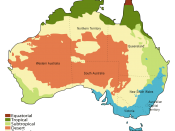Australia is a classic country for immigration. It is an attractive country for migrants, with its friendly, multi-cultural society, most mild climates and a strong, vibrant economy. In the past 20 years Australia has "experienced large-scale immigration" from a new source of countries, particularly from Asia (Castles & Miller, 1993, pp.5). Australia's permanent immigration program has two components - Migration (non-Humanitarian) for skilled and family migrants and Humanitarian, for refugees and others with humanitarian needs (DIMIA, 2004). This essay will critically analyse Australian immigration policy and its relation to Asia.
Before analysing Australians immigration policy, it is important to define what a migration and asylum seeker is. Papastergiadis (2000, pp.54) defined 'migration' as the process of people's movement through national boundaries. Migration is not only an issue of Australia and Asia, but it is also a global phenomenon. In 1990, according to the International Organisation for Migration (IOM) estimate, there were 80 million international migrants, including all types of migrants whether documented or not (Castles & Miller, 1993, pp.4).
People migrate individually or in groups and all have an affect on the place where they settle. They have affected the world's regions in different ways. Castles & Miller (1993, pp.5) considered that international migration has rebuilt global societies and politics, which is "part of a transnational revolution." When we talk about immigration, it cannot be ignored that asylum seekers are the special groups of migrants. Asylum seekers are "people who apply to the government of a country for recognition as a refugee"(DIMIA, 2004). If they are successful, they are offered protection in that country.
The Australian government initiated an immigration policy after the end of World War II. The new policy considered that the lower population needed to be increased. The initial plan, which "was 70,000...



Australian immigration policy
Nice work. Very good references and looks like they took more time to do than ur essay there that long. Well, a good bilography is a sign of a good writter. All in all very good work and it shows because of the fulency of your writting, the language you use to portray it and the length, so i say to you again, good work and a nice effort!
5 out of 5 people found this comment useful.